Labour Statistics: Research Papers
Annual review of the labour market, 2017
by Andrew Fields, Emmanuelle Bourbeau and Martha Patterson
Skip to text
Text begins
Introduction and overview
This article analyses the Canadian labour market in 2017. The focus is on national trends as well as key provincial and industrial sector changes.
In general, consistent signals across key labour market indicators pointed to a tightening of the labour market, including the fastest total employment growth in a decade and a downward trend in the national unemployment rate. At the same time, average weekly earnings increased notably, the number of regular Employment Insurance (EI) beneficiaries declined, and the job vacancy rate increased. All of these changes coincided with stronger economic growth, as the real gross domestic product grew 3.0% in 2017, following growth of 1.4% in 2016.Note
The analysis in this article uses a combination of major labour market indicators from different sources. All analysis is based on annual averages, unless otherwise noted. The Labour Force Survey (LFS) is used primarily for data on unemployment and employment details for demographic groups. The Survey of Employment, Payrolls and Hours (SEPH) is used for payroll employment by industrial sector as well as average weekly earnings and hours for employees. Data from the Job Vacancy and Wage Survey (JVWS) and from EI statistics are also used.
Fastest employment growth rate in a decade, driven by increases in full-time work
Between 2016 and 2017, total employment rose by 336,500 or 1.9%, the fastest annual rate of growth in a decade.Note This follows three years of increases below 1.0%. Most of the growth was in full-time work (+280,600 or +1.9%).
Employment gains were spread across several provinces, led by Ontario, Quebec and British Columbia. At the same time, there was a notable decline in Newfoundland and Labrador. At the national level, the largest increase was among people in the core working age group (25 to 54). This was in contrast to 2016, when core-aged employment was virtually unchanged.
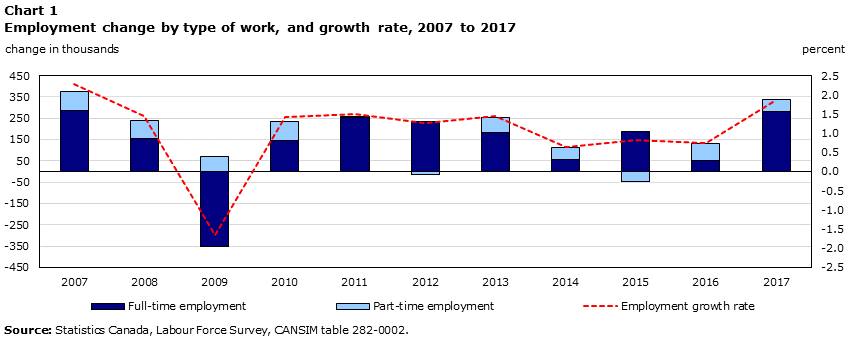
Data table for Chart 1
| Year | Employment growth rate | Full-time employment | Part-time employment |
|---|---|---|---|
| percent | change in thousands | ||
| 2007 | 2.3 | 285.3 | 88.0 |
| 2008 | 1.4 | 152.6 | 88.3 |
| 2009 | -1.7 | -352.1 | 69.5 |
| 2010 | 1.4 | 144.6 | 92.1 |
| 2011 | 1.5 | 253.7 | 3.1 |
| 2012 | 1.3 | 232.3 | -15.5 |
| 2013 | 1.5 | 181.0 | 72.2 |
| 2014 | 0.6 | 55.7 | 55.4 |
| 2015 | 0.8 | 189.4 | -45.0 |
| 2016 | 0.7 | 52.9 | 80.4 |
| 2017 | 1.9 | 280.6 | 55.9 |
| Source: Statistics Canada, Labour Force Survey, CANSIM table 282-0002. | |||
Unemployment rate trends down, participation rate edges up
Using annual data, the unemployment rate was 6.3% in 2017, down 0.7 percentage points compared with 2016. This was the largest decline since 2000. The unemployment rate fell among every major demographic group in 2017. Provincially, the lowest unemployment rate was in British Columbia (5.1%), and the highest was in Newfoundland and Labrador (14.8%).
On a monthly basis, the unemployment rate trended down throughout 2017, reaching 5.8% in December—matching a record-low previously observed in October 2007.Note The unemployment rate at the end of 2017 was 1.1 percentage points lower than 12 months earlier. For most OECD (Organization for Economic Co-operation and Development) countries, the unemployment rate also trended down in 2017, as economic conditions strengthened for this group of countries.Note In December 2017, the unemployment rate in Canada was in line with the total OECD harmonised average unemployment rate of 5.5%.
The participation rate—the proportion of the population either working or looking for work—rose for the first time since 2008, increasing by 0.1 percentage points to 68.5% in 2017.Note This was driven by increased participation among the core age population, particularly for women in this age group, which brought the core age participation rate to a record high of 87.0% (+0.5 percentage points compared with 2016). Labour force participation among people aged 55 and older continued its long-term upward trend, which is associated with the aging of the population as well as other social and economic factors.
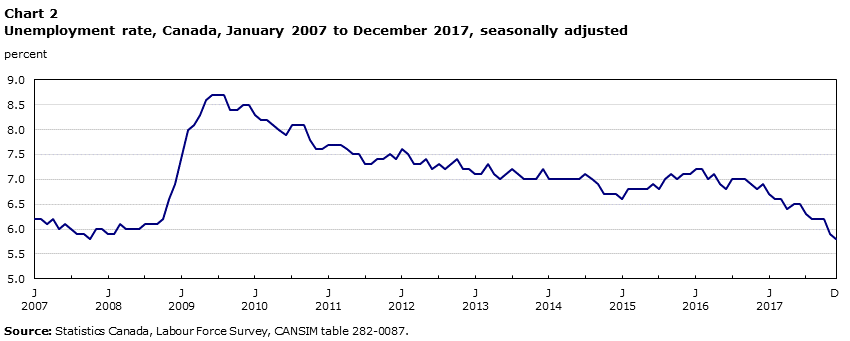
Data table for Chart 2
| Unemployment rate | |
|---|---|
| percent | |
| 2007 | |
| January | 6.2 |
| February | 6.2 |
| March | 6.1 |
| April | 6.2 |
| May | 6.0 |
| June | 6.1 |
| July | 6.0 |
| August | 5.9 |
| September | 5.9 |
| October | 5.8 |
| November | 6.0 |
| December | 6.0 |
| 2008 | |
| January | 5.9 |
| February | 5.9 |
| March | 6.1 |
| April | 6.0 |
| May | 6.0 |
| June | 6.0 |
| July | 6.1 |
| August | 6.1 |
| September | 6.1 |
| October | 6.2 |
| November | 6.6 |
| December | 6.9 |
| 2009 | |
| January | 7.4 |
| February | 8.0 |
| March | 8.1 |
| April | 8.3 |
| May | 8.6 |
| June | 8.7 |
| July | 8.7 |
| August | 8.7 |
| September | 8.4 |
| October | 8.4 |
| November | 8.5 |
| December | 8.5 |
| 2010 | |
| January | 8.3 |
| February | 8.2 |
| March | 8.2 |
| April | 8.1 |
| May | 8.0 |
| June | 7.9 |
| July | 8.1 |
| August | 8.1 |
| September | 8.1 |
| October | 7.8 |
| November | 7.6 |
| December | 7.6 |
| 2011 | |
| January | 7.7 |
| February | 7.7 |
| March | 7.7 |
| April | 7.6 |
| May | 7.5 |
| June | 7.5 |
| July | 7.3 |
| August | 7.3 |
| September | 7.4 |
| October | 7.4 |
| November | 7.5 |
| December | 7.4 |
| 2012 | |
| January | 7.6 |
| February | 7.5 |
| March | 7.3 |
| April | 7.3 |
| May | 7.4 |
| June | 7.2 |
| July | 7.3 |
| August | 7.2 |
| September | 7.3 |
| October | 7.4 |
| November | 7.2 |
| December | 7.2 |
| 2013 | |
| January | 7.1 |
| February | 7.1 |
| March | 7.3 |
| April | 7.1 |
| May | 7.0 |
| June | 7.1 |
| July | 7.2 |
| August | 7.1 |
| September | 7.0 |
| October | 7.0 |
| November | 7.0 |
| December | 7.2 |
| 2014 | |
| January | 7.0 |
| February | 7.0 |
| March | 7.0 |
| April | 7.0 |
| May | 7.0 |
| June | 7.0 |
| July | 7.1 |
| August | 7.0 |
| September | 6.9 |
| October | 6.7 |
| November | 6.7 |
| December | 6.7 |
| 2015 | |
| January | 6.6 |
| February | 6.8 |
| March | 6.8 |
| April | 6.8 |
| May | 6.8 |
| June | 6.9 |
| July | 6.8 |
| August | 7.0 |
| September | 7.1 |
| October | 7.0 |
| November | 7.1 |
| December | 7.1 |
| 2016 | |
| January | 7.2 |
| February | 7.2 |
| March | 7.0 |
| April | 7.1 |
| May | 6.9 |
| June | 6.8 |
| July | 7.0 |
| August | 7.0 |
| September | 7.0 |
| October | 6.9 |
| November | 6.8 |
| December | 6.9 |
| 2017 | |
| January | 6.7 |
| February | 6.6 |
| March | 6.6 |
| April | 6.4 |
| May | 6.5 |
| June | 6.5 |
| July | 6.3 |
| August | 6.2 |
| September | 6.2 |
| October | 6.2 |
| November | 5.9 |
| December | 5.8 |
| Source: Statistics Canada, Labour Force Survey, CANSIM table 282-0087. | |
Employment Insurance recipients decline, job vacancies rise
The number of people receiving regular EI benefits was 529,700 in 2017, down 6.0% from 2016.Note This follows two years of increases. The declines were most notable in Alberta and Quebec, while the number of beneficiaries rose the most in Newfoundland and Labrador.
At the same time, there was a higher number of vacancies among employers—the average number of job vacancies over the four quarters of 2017 rose 18.2% in comparison with the average of 2016.Note The average job vacancy rate—the number of job vacancies expressed as a percentage of all occupied and vacant jobs—over the four quarters in 2017 was 2.8%, up from 2.4% in 2016.
The unemployment-to-job vacancy ratio—the number of unemployed people divided by the number of job vacancies—declined in 2017.Note There were 2.8 unemployed people for each job vacancy (down from 3.6 observed in 2016).Note This is a due to a combination of fewer unemployed people as well as a rise in the number of vacant positions being reported by employers.
Average weekly earnings increase in most provinces
Following a record-low annual earnings growth of 0.5% in 2016, average weekly earnings of non-farm payroll employees increased by 2.0% to $976 in 2017.Note This growth rate was similar to the one observed in 2015 (+1.8%). Average weekly earnings trended upward in the second half of 2017. As a comparison, the annual average increase in the Consumer Price Index (CPI) was 1.6% in 2017.Note
In general, changes in weekly earnings reflect a number of factors, including wage growth; changes in the composition of employment by industry, occupation and level of job experience; and average hours worked per week.
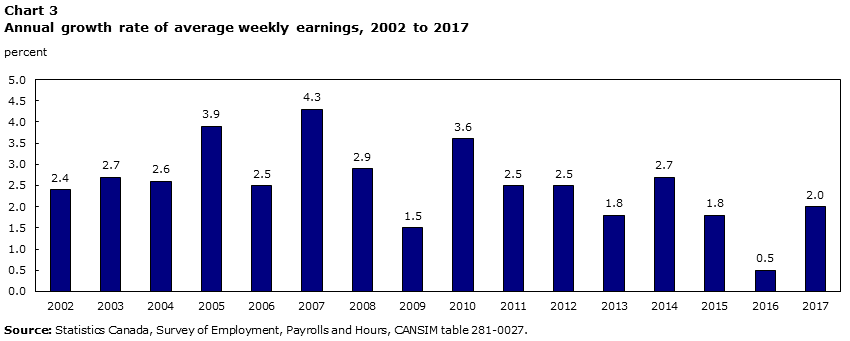
Data table for Chart 3
| Year | Average weekly earnings growth rate |
|---|---|
| percent | |
| 2002 | 2.4 |
| 2003 | 2.7 |
| 2004 | 2.6 |
| 2005 | 3.9 |
| 2006 | 2.5 |
| 2007 | 4.3 |
| 2008 | 2.9 |
| 2009 | 1.5 |
| 2010 | 3.6 |
| 2011 | 2.5 |
| 2012 | 2.5 |
| 2013 | 1.8 |
| 2014 | 2.7 |
| 2015 | 1.8 |
| 2016 | 0.5 |
| 2017 | 2.0 |
| Source: Statistics Canada, Survey of Employment, Payrolls and Hours, CANSIM table 281-0027. | |
Average weekly earnings grew in almost all provinces; and in the majority, the growth rate was higher in 2017 than in 2016. Growth in average weekly earnings was above the national average in Quebec (+2.8% to $903), British Columbia (+2.5% to $943), Manitoba (+2.5% to $911) and Saskatchewan (+2.2% to $1,010).Note
Alberta saw the most notable change in the growth rate in comparison with 2016, with average weekly earnings increasing 1.0% to $1,130 in 2017, after declining 2.4% in 2016. In Prince Edward Island, average weekly earnings were little changed in 2017.
Hours trend up for employees paid by the hour, hold steady for salaried employees
After trending downward through 2016 and reaching a recent low point in April 2017, average hours among hourly paid employees—who represent about 60% of non-farm payroll employment—trended upward through most of 2017.Note However, on an annual basis, average weekly hours were little changed from 30.2 hours per week in 2016 to 30.1 hours per week in 2017.
For salaried employees, the regular work week was also little changed in 2017, at 36.9 hours per week on average. The regular work week for salaried employees has been hovering around that level since 2009.
Employment increases in both goods- and services-producing sectors
Most of the non-farm payroll employment growth in 2017 was driven by services-producing sectors, which rose by 219,900 (+1.7%), the largest level increase since 2008.Note Health care and social assistance was the main contributor. There were also notable increases in accommodation and food services; professional, scientific and technical services; as well as educational services.
Payroll employment growth in services-producing sectors has typically outpaced goods-producing sectors over the past decade, except for a brief period between 2010 and 2012, when goods-producing sectors increased at a faster rate, due mostly to increases in natural resources and construction.
Following two consecutive years of declines, employment in goods-producing sectors rose by 64,400 (+2.3%) in 2017. This growth was led by manufacturing and construction. Employment in the mining, quarrying, and oil and gas extraction sector recovered slightly.
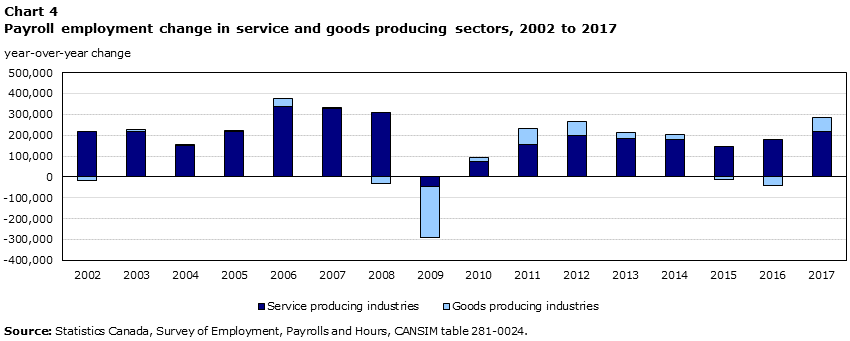
Data table for Chart 4
| Year | Service producing industries | Goods producing industries |
|---|---|---|
| year-over-year change | ||
| 2002 | 218,876 | -15,269 |
| 2003 | 217,438 | 9,027 |
| 2004 | 149,611 | 1,244 |
| 2005 | 217,856 | 6,441 |
| 2006 | 339,158 | 38,709 |
| 2007 | 326,275 | 1,357 |
| 2008 | 306,839 | -33,031 |
| 2009 | -44,136 | -246,970 |
| 2010 | 72,726 | 20,701 |
| 2011 | 154,009 | 79,563 |
| 2012 | 197,829 | 69,989 |
| 2013 | 182,831 | 31,553 |
| 2014 | 179,321 | 22,945 |
| 2015 | 145,138 | -10,974 |
| 2016 | 181,430 | -43,357 |
| 2017 | 219,933 | 64,373 |
| Source: Statistics Canada, Survey of Employment, Payrolls and Hours, CANSIM table 281-0024. | ||
Health care and social assistance jobs continue to rise
For the fourth consecutive year, health care and social assistance was the largest contributor to payroll employment growth, rising 39,600 (+2.1%) in 2017. This brought the total number of employees in this sector to 1.9 million, the second-largest sector by employment (behind the 2.0 million in retail trade).
The biggest employment increase for the health care and social assistance sector was in Ontario (+14,600 or +2.1%), and to a lesser extent Quebec (+8,400 or +1.9%), reflecting their larger populations. However, the rate of employment growth outpaced the national average in Manitoba (+3.2% or +2,900), British Columbia (+2.7% or +6,900) and Alberta (+2.6% or +4,900).
At the national level, increases in health care and social assistance were spread across several industries, led by general medical and surgical hospitals, individual and family services, as well as community care facilities for the elderly. Employment in community care facilities for the elderly has more than doubled since 2006, reflecting the needs of an aging population. The number of people aged 65 and older increased by 36.9% between 2006 and 2016.Note
The unemployed-to-job-vacancy ratio in health care and social assistance was 0.9 in 2017, which means there are more job vacancies than unemployed persons in that sector.Note
Average weekly earnings in health care and social assistance were $889 in 2017, an increase of 2.6% from a year earlier. While average earnings in this sector were slightly below the national average, there was large variation within industries: employees in offices of physicians earned on average $1,152 per week, while employees in home health care services earned $675 on average per week. Most of the growth in 2017 was led by gains in the largest industry, that is, general medical and surgical hospitals.Note

Data table for Chart 5
| Payroll employment, 2017 | |
|---|---|
| year-over-year change | |
| Health care and social assistance | 39,620 |
| Accommodation and food services | 31,403 |
| Professional, scientific and technical services | 29,305 |
| Manufacturing | 26,811 |
| Construction | 25,995 |
| Educational services | 25,925 |
| Public administration | 22,263 |
| Retail trade | 16,976 |
| Administrative and support services | 14,025 |
| Transportation and warehousing | 13,193 |
| Mining and quarrying, and oil and gas extraction | 9,957 |
| Arts, entertainment and recreation | 9,558 |
| Wholesale trade | 4,736 |
| Other services (except public administration) | 4,139 |
| Information and cultural industries | 3,789 |
| Finance and insurance | 3,372 |
| Real estate and rental and leasing | 1,990 |
| Utilities | 1,819 |
| Forestry, logging and support | -209 |
| Management of companies and enterprises | -359 |
| Source: Statistics Canada, Survey of Employment, Payrolls and Hours, CANSIM table 281-0024. | |
Employment gains in restaurants
Employment in accommodation and food services increased by 31,400 (+2.5%) in 2017, with more than half of the increase in Ontario (+19,500 or +4.2%). The gains were almost entirely in full-service restaurants and limited-service eating places, with smaller increases in traveller accommodation. The rate of employment growth in the accommodation and food services sector has exceeded the national average growth rate each year since 2011. In total, this sector had 1.3 million employees in 2017.
Average weekly earnings in accommodation and food services were the lowest among the sectors, with an average of $383 a week; however, earnings rose 3.4% compared with 2016, outpacing the national average growth rate. Accommodation and food services had the second highest job vacancy rate of all sectors on average over the four quarters in 2017, rising 0.5 percentage points to 4.5%.Note This is partly the result of high turnover in this sector.
Tech jobs growing at a fast pace
One of the fastest growing sectors in 2017 was professional, scientific and technical services, which rose 3.4%, adding 29,300 payroll jobs. This is the fastest pace of growth in the sector since 2008. In total there were 892,000 employees in this sector.Note
Employment growth in professional, scientific and technical services was almost entirely driven by Ontario (+14,100 or +3.8%) and Quebec (+10,600 or +5.7%). For the professional, scientific and technical services sector as a whole, average weekly earnings were $1,347 (+2.3%). There was a relatively high job vacancy rate in this sector, at 3.1% on average for 2017, in line with the rate observed for 2016.Note
Most of the employment growth in the sector was in computer systems design and related services, which grew by 19,100 (+9.2%). This is a high-skilled and high-earning industry, with average weekly earnings of $1,577 (up 2.9% from 2016).Note
Strongest manufacturing growth in over a decade
In 2017, manufacturing had the strongest employment growth since comparable data became available in 2001, adding 26,800 payroll jobs and growing at a pace of 1.8%. In total, there were 1.5 million employees in manufacturing, the third largest sector by employment. However, despite recent gains, there were nearly half a million fewer payroll employees in manufacturing compared with 2001.

Data table for Chart 6
| Year | Manufacturing |
|---|---|
| thousands | |
| 2001 | 1,977.6 |
| 2002 | 1,930.6 |
| 2003 | 1,911.4 |
| 2004 | 1,871.9 |
| 2005 | 1,840.9 |
| 2006 | 1,822.1 |
| 2007 | 1,764.6 |
| 2008 | 1,680.7 |
| 2009 | 1,493.3 |
| 2010 | 1,477.4 |
| 2011 | 1,499.3 |
| 2012 | 1,509.9 |
| 2013 | 1,502.6 |
| 2014 | 1,493.0 |
| 2015 | 1,498.9 |
| 2016 | 1,482.1 |
| 2017 | 1,508.9 |
| Source: Statistics Canada, Survey of Employment, Payrolls and Hours, CANSIM table 281-0024. | |
Gains in 2017 were spread across several subsectors, with the largest increases observed in food, as well as beverage and tobacco product manufacturing (+5,400 or +2.4% and +4,200 or +11.2%). There was also some contribution from transportation equipment manufacturing (+3,800 or +2.0%), particularly in motor vehicle parts manufacturing and motor vehicle and trailer manufacturing.
Most of the growth in manufacturing was in Quebec (+12,000 or +3.0%) and Ontario (+8,400 or +1.3%). To a lesser extent, there were increases in British Columbia and Alberta. At the same time, employment in manufacturing fell by 1,900 (-15.6%) in Newfoundland and Labrador, mostly in seafood product preparation and packaging.
Weekly earnings in manufacturing were $1,097 on average per week in 2017, virtually unchanged compared with 2016. The job vacancy rate for manufacturing was 2.5% on average for 2017, below the national rate for all sectors.Note
The employment growth coincides with an upward trend in manufacturing sales, which rose by 3.3% in 2017—the highest pace of annual growth since 2010.Note
Employment in mining, quarrying, and oil and gas extraction rebounds after two years of losses
Employment in mining, quarrying, and oil and gas extraction rose by 10,000 (+5.2%) in 2017.Note This follows two consecutive years of losses that resulted in an 18.1% decline in payroll employment for this sector from 2014 to 2016. Most of the decrease over this period was related to declines in global oil prices, with employees in Alberta most affected by this change.
In 2017, just under half of the increase in mining, quarrying, and oil and gas extraction was in Alberta (+4,700 or +4.8%). The increase in the province was led by “support activities”, which includes occupations such as oil and gas well drillers, servicers, testers and related workers. This subsector had the largest decline in employment following the oil price shock and, despite the recent increase, is still below its 2014 peak. Employment in the higher-paid “oil and gas extraction” subsector continued to trend downward in 2017.
There were also increases in mining, quarrying, and oil and gas extraction spread across British Columbia (+1,600 or +9.0%), Quebec (+1,400 or +8.5%) and Ontario (+1,200 or +5.0%). For these provinces, the rise was mostly in the metal ore mining industry.
In Newfoundland and Labrador, employment in the sector was virtually unchanged in 2017. This is in contrast to notable growth from 2007 to 2014, during which employment in the sector grew by 8.4% due to oil exploration and investment in the province.
On average, the job vacancy rate in 2017 for mining, quarrying and oil and gas extraction rose notably, up from 1.2% in 2016 to 2.3% in 2017.Note
Wholesale trade has highest average weekly earnings growth
Looking at sectors, earnings grew the most in wholesale trade and in finance and insurance.
Earnings in wholesale trade grew by 4.1% to $1,203, led by gains among wholesalers of machinery, equipment and supplies. The number of payroll employees in the sector has been on an upward trend throughout most of 2017, coinciding with increasing sales.Note Provincially, Ontario contributed the most to the earnings rise in the sector.

Data table for Chart 7
| Sales in current dollars (left axis) | Payroll employment (right axis) | |
|---|---|---|
| billions | thousands | |
| 2001 | ||
| January | 31.5 | 733.6 |
| February | 31.1 | 736.0 |
| March | 30.8 | 733.2 |
| April | 31.0 | 725.2 |
| May | 31.0 | 727.4 |
| June | 32.1 | 726.3 |
| July | 32.3 | 717.7 |
| August | 32.3 | 718.6 |
| September | 32.1 | 711.7 |
| October | 31.3 | 713.3 |
| November | 31.2 | 708.9 |
| December | 31.7 | 708.4 |
| 2002 | ||
| January | 32.7 | 709.5 |
| February | 33.0 | 711.8 |
| March | 33.0 | 714.5 |
| April | 33.4 | 714.5 |
| May | 33.8 | 718.4 |
| June | 33.4 | 720.2 |
| July | 34.0 | 723.4 |
| August | 34.5 | 725.6 |
| September | 34.4 | 724.8 |
| October | 34.6 | 726.0 |
| November | 35.1 | 728.3 |
| December | 34.8 | 730.6 |
| 2003 | ||
| January | 35.2 | 730.7 |
| February | 35.3 | 730.6 |
| March | 34.9 | 733.0 |
| April | 34.1 | 734.7 |
| May | 33.9 | 733.0 |
| June | 34.2 | 732.3 |
| July | 34.4 | 730.6 |
| August | 32.6 | 729.6 |
| September | 34.8 | 730.6 |
| October | 34.9 | 736.9 |
| November | 35.4 | 732.9 |
| December | 35.7 | 731.0 |
| 2004 | ||
| January | 35.2 | 732.0 |
| February | 35.4 | 726.6 |
| March | 36.1 | 726.7 |
| April | 36.4 | 728.4 |
| May | 37.0 | 730.5 |
| June | 37.6 | 729.0 |
| July | 36.5 | 729.7 |
| August | 37.6 | 727.7 |
| September | 37.7 | 731.1 |
| October | 37.5 | 726.7 |
| November | 38.0 | 728.3 |
| December | 38.0 | 728.5 |
| 2005 | ||
| January | 38.1 | 727.2 |
| February | 38.6 | 728.6 |
| March | 38.0 | 728.4 |
| April | 38.4 | 728.0 |
| May | 38.6 | 724.4 |
| June | 39.3 | 726.2 |
| July | 37.8 | 727.3 |
| August | 39.1 | 726.7 |
| September | 39.8 | 729.1 |
| October | 40.5 | 727.3 |
| November | 40.3 | 728.5 |
| December | 40.2 | 725.8 |
| 2006 | ||
| January | 40.6 | 729.4 |
| February | 40.5 | 734.9 |
| March | 40.5 | 733.0 |
| April | 40.9 | 735.9 |
| May | 41.2 | 736.0 |
| June | 40.7 | 738.9 |
| July | 40.9 | 741.1 |
| August | 41.3 | 742.7 |
| September | 40.9 | 740.6 |
| October | 40.7 | 737.4 |
| November | 41.1 | 742.6 |
| December | 43.0 | 747.8 |
| 2007 | ||
| January | 42.2 | 751.3 |
| February | 43.4 | 753.7 |
| March | 43.9 | 752.5 |
| April | 43.3 | 754.2 |
| May | 43.4 | 758.2 |
| June | 43.3 | 758.6 |
| July | 43.0 | 758.0 |
| August | 43.1 | 760.3 |
| September | 43.2 | 760.1 |
| October | 43.5 | 761.1 |
| November | 43.5 | 759.7 |
| December | 42.3 | 758.5 |
| 2008 | ||
| January | 42.9 | 759.1 |
| February | 42.8 | 758.4 |
| March | 43.0 | 759.6 |
| April | 44.0 | 757.8 |
| May | 45.5 | 758.1 |
| June | 45.6 | 760.1 |
| July | 46.1 | 759.9 |
| August | 45.8 | 755.6 |
| September | 45.9 | 759.9 |
| October | 45.2 | 759.8 |
| November | 44.1 | 757.8 |
| December | 42.5 | 752.5 |
| 2009 | ||
| January | 40.6 | 748.0 |
| February | 40.5 | 742.8 |
| March | 40.3 | 740.1 |
| April | 40.4 | 733.8 |
| May | 40.2 | 731.3 |
| June | 40.8 | 727.1 |
| July | 42.0 | 726.3 |
| August | 41.6 | 726.0 |
| September | 41.7 | 725.1 |
| October | 41.9 | 724.5 |
| November | 43.1 | 724.7 |
| December | 43.4 | 725.5 |
| 2010 | ||
| January | 43.6 | 724.6 |
| February | 43.4 | 725.5 |
| March | 43.6 | 725.8 |
| April | 43.8 | 730.7 |
| May | 43.6 | 729.5 |
| June | 43.7 | 730.3 |
| July | 43.3 | 730.7 |
| August | 44.0 | 729.5 |
| September | 44.5 | 735.1 |
| October | 44.4 | 733.7 |
| November | 44.9 | 732.9 |
| December | 45.4 | 736.5 |
| 2011 | ||
| January | 46.4 | 738.7 |
| February | 45.5 | 744.5 |
| March | 46.1 | 742.6 |
| April | 45.7 | 744.6 |
| May | 46.2 | 739.0 |
| June | 46.4 | 744.7 |
| July | 47.1 | 746.0 |
| August | 47.2 | 746.6 |
| September | 47.8 | 750.8 |
| October | 48.2 | 744.9 |
| November | 47.9 | 747.7 |
| December | 48.6 | 746.5 |
| 2012 | ||
| January | 48.1 | 750.4 |
| February | 48.6 | 748.4 |
| March | 49.2 | 751.8 |
| April | 49.3 | 750.9 |
| May | 49.1 | 753.9 |
| June | 49.6 | 756.5 |
| July | 49.3 | 758.5 |
| August | 49.1 | 760.4 |
| September | 48.6 | 759.7 |
| October | 48.8 | 762.1 |
| November | 49.3 | 762.9 |
| December | 49.0 | 762.0 |
| 2013 | ||
| January | 49.4 | 761.0 |
| February | 49.5 | 763.6 |
| March | 49.6 | 769.7 |
| April | 49.4 | 764.1 |
| May | 49.9 | 762.6 |
| June | 48.7 | 761.2 |
| July | 49.8 | 761.1 |
| August | 49.9 | 763.3 |
| September | 50.0 | 762.7 |
| October | 50.6 | 767.7 |
| November | 50.6 | 769.2 |
| December | 50.1 | 772.5 |
| 2014 | ||
| January | 50.2 | 772.0 |
| February | 51.3 | 773.6 |
| March | 51.3 | 773.8 |
| April | 51.6 | 773.5 |
| May | 53.1 | 781.6 |
| June | 53.1 | 779.6 |
| July | 52.8 | 779.9 |
| August | 53.0 | 781.5 |
| September | 54.4 | 782.2 |
| October | 54.0 | 781.9 |
| November | 53.4 | 783.6 |
| December | 55.6 | 782.8 |
| 2015 | ||
| January | 53.4 | 783.2 |
| February | 53.6 | 784.3 |
| March | 54.1 | 783.6 |
| April | 55.1 | 787.1 |
| May | 54.4 | 786.1 |
| June | 55.0 | 782.3 |
| July | 55.1 | 783.7 |
| August | 55.2 | 778.1 |
| September | 55.0 | 782.5 |
| October | 55.0 | 786.2 |
| November | 56.2 | 780.0 |
| December | 57.7 | 778.7 |
| 2016 | ||
| January | 56.6 | 778.3 |
| February | 55.4 | 776.0 |
| March | 54.7 | 777.8 |
| April | 55.3 | 774.8 |
| May | 55.9 | 773.7 |
| June | 56.5 | 775.0 |
| July | 56.7 | 773.8 |
| August | 57.1 | 771.8 |
| September | 56.4 | 774.1 |
| October | 57.3 | 770.9 |
| November | 57.4 | 769.6 |
| December | 58.5 | 772.1 |
| 2017 | ||
| January | 59.5 | 773.6 |
| February | 59.8 | 774.5 |
| March | 60.5 | 771.6 |
| April | 61.2 | 772.7 |
| May | 61.8 | 773.7 |
| June | 61.4 | 778.1 |
| July | 62.5 | 779.4 |
| August | 62.8 | 784.2 |
| September | 62.1 | 780.4 |
| October | 63.2 | 781.8 |
| November | 63.3 | 784.3 |
| December | 63.2 | 790.6 |
| Sources: Statistics Canada, Survey of Employment, Payrolls and Hours, CANSIM table 281-0047 and Monthly Wholesale Trade Survey, CANSIM table 081-0011. | ||
In finance and insurance, average weekly earnings were up 3.7% to $1,307 in 2017, primarily driven by credit intermediation and related activities. Despite being a smaller sector, finance and insurance was one of the largest contributors to the overall earnings growth.
Growth in public sector employees outpaces private sector employees and self-employed
The number of employees in the public sectorNote increased by 94,000 (+2.6%) in 2017, the largest and most rapid annual increase since 2008. In the private sector, the number of employees increased by 206,000 (+1.8%), following two years of growth below 1.0%.Note
The number of self-employed workers increased in 2017 (+37,000 or +1.3%), following slower growth in 2016 and matching the pace of growth observed in 2015. This was driven by self-employed who are incorporated but have no paid help.
Employment increases in most provinces, while it declines in Newfoundland and Labrador
Since 2014 there was a slight reversal of the trends observed earlier in the 2000s. Ontario, Quebec, and British Columbia drove most of the employment growth, while provinces such as Alberta and Newfoundland and Labrador lacked the strength observed earlier in the period. In 2017, the unemployment rate declined in most provinces, while it increased notably in Newfoundland and Labrador.
Largest employment gains in Ontario
Employment increases in 2017 were led by Ontario, which had 128,400 (+1.8%) more people employed, mostly in full-time work (+106,100 or 1.9%).Note This was the fastest rate of total employment growth for the province since 2013. The unemployment rate in Ontario was 6.0% in 2017, down 0.5 percentage points from the previous year—the lowest rate since 2000.
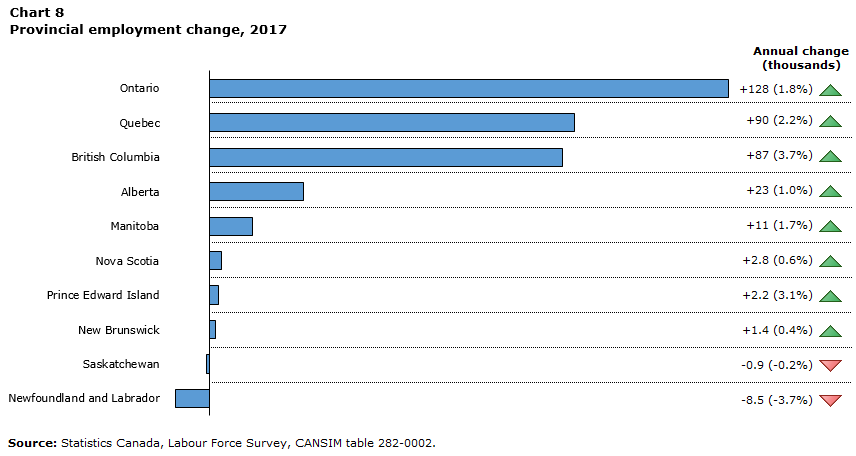
Data table for Chart 8
| Annual change | ||
|---|---|---|
| thousands | percent | |
| Ontario | 128 | 1.8 |
| Quebec | 90 | 2.2 |
| British Columbia | 87 | 3.7 |
| Alberta | 23 | 1.0 |
| Manitoba | 11 | 1.7 |
| Nova Scotia | 2.8 | 0.6 |
| Prince Edward Island | 2.2 | 3.1 |
| New Brunswick | 1.4 | 0.4 |
| Saskatchewan | -0.9 | -0.2 |
| Newfoundland and Labrador | -8.5 | -3.7 |
| Source: Statistics Canada, Labour Force Survey, CANSIM table 282-0002. | ||
Employment growth in Ontario was spread across several economic regions, led by Toronto (+69,700 or +2.1%); Hamilton–Niagara Peninsula (+28,700 or +4.0%); Kitchener–Waterloo–Barrie (+17,700 or +2.5%); and Muskoka-Kawarthas (+10,800 or 6.3%).Note
By sector, the largest non-farm payroll employment growth in Ontario was in accommodation and food services (+19,500 or +4.2%); health care and social assistance (+14,600 or +2.1%) and professional, scientific and technical services (+14,100 or +3.8%).Note
The job vacancy rate for Ontario was 2.9% in 2017, similar to the national average. This was up slightly from 2.6% observed in 2016.Note The number of people receiving regular EI benefits in Ontario was 133,500, a decline of 4.6% from 2016.Note
British Columbia has fastest rate of employment growth, lowest unemployment rate
There was above-average employment growth in British Columbia (+3.7% or +87,300) in 2017.Note It also had the lowest unemployment rate among the provinces at 5.1% (down 0.9 percentage points from 2016). Most of the employment increase in British Columbia was in the Lower Mainland–Southwest economic region (+49,200 or +3.2%), but it was also spread across several of the smaller regions; most notably Vancouver Island and Coast (+20,100 or +5.5%).Note
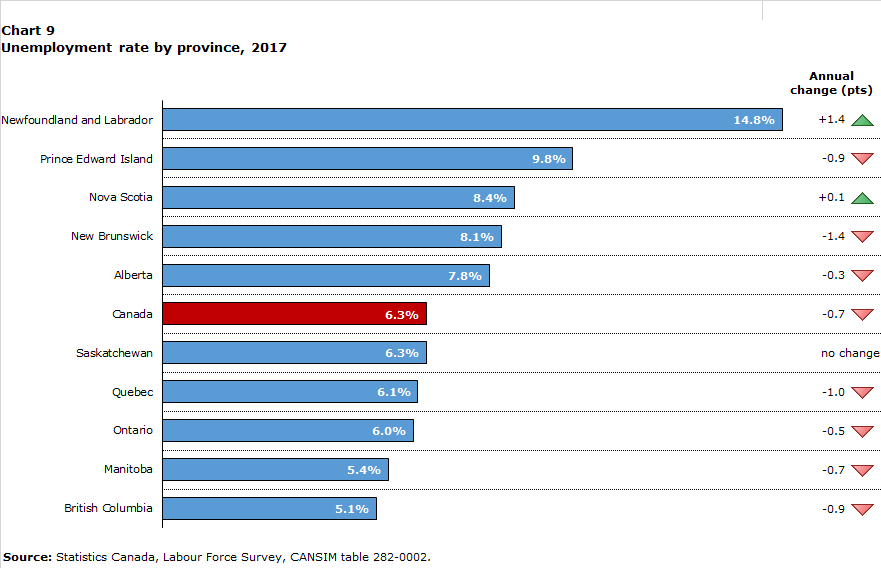
Data table for Chart 9
| Unemployment rate | Annual change | |
|---|---|---|
| percent | percentage points | |
| Newfoundland and Labrador | 14.8 | +1.4 |
| Prince Edward Island | 9.8 | -0.9 |
| Nova Scotia | 8.4 | +0.1 |
| New Brunswick | 8.1 | -1.4 |
| Alberta | 7.8 | -0.3 |
| Canada | 6.3 | -0.7 |
| Saskatchewan | 6.3 | no change |
| Quebec | 6.1 | -1.0 |
| Ontario | 6.0 | -0.5 |
| Manitoba | 5.4 | -0.7 |
| British Columbia | 5.1 | -0.9 |
| Source: Statistics Canada, Labour Force Survey, CANSIM table 282-0002. | ||
The sectors with the largest payroll employment increase were accommodation and food services (+9,400 or +4.2%); construction (+7,100 or +4.9%); and health care and social assistance (+6,900 or +2.7%).Note
Average earnings for the province rose 2.5% to $943 per week in 2017. At the same time, the job vacancy rate in British Columbia was the highest among the provinces at 3.8% on average for 2017.Note The number of people receiving regular EI benefits declined by 7.7%.Note
Strong labour market trends in Quebec
There were positive trends in the Quebec labour market in 2017, driven by employment growth of 90,200 (+2.2%)—the largest level increase since 2007.Note Most of the growth was in full-time employment (+65,400 or +2.0%). At the same time, the annual unemployment rate fell 1.0 percentage point to 6.1%. The unemployment rate in Quebec trended down over the previous two years, falling to 5.0% in December 2017, the lowest rate since comparable data became available in January 1976.Note
Most of the employment growth in Quebec was in the Montreal (+38,900 or +3.9%) and Montérégie (+32,300 or +4.2%) economic regions.Note By sector, payroll employment increases were spread across most sectors, led by manufacturing (+12,000 or +3.0%) as well as professional, scientific and technical services (+10,600 or +5.7%).Note
There were other indicators which showed similar positive trends; in 2017 the earnings growth rate was above the national average at 2.8% (bringing average weekly earnings to $903), driven by increased earnings in several sectors, most notably: health care and social assistance as well as professional, scientific and technical services. The job vacancy rate rose 0.5 percentage points to 2.4% on average over the four quarters of 2017.Note There was also a decline in the number of people receiving regular EI benefits, down 8.6% to 129,900—the lowest level on record for the province.Note
Employment level and unemployment rate in Alberta not fully recovered
In Alberta, employment rose by 23,100 (+1.0%) in 2017, entirely in full-time work.Note This followed a decline in 2016, mostly the result of the oil price shock which began in the fall of 2014. Total employment in 2017 was still slightly below the peak level observed in 2015. The 1.0% pace of employment growth observed in 2017 was below the annual average growth rate of 3.0% observed between 2011 and 2014.
While the unemployment rate in Alberta trended down throughout 2017, reaching 7.0% in December (1.6 percentage points lower compared with 12 months earlier), it was still considerably higher than the 4.4% observed in November 2014, before the unemployment rate began to rise sharply in response to falling global oil prices.Note On an annual basis, the unemployment rate was 7.8% in 2017.Note

Data table for Chart 10
| Unemployment rate | Crude oil prices: West Texas Intermediate (WTI) | |
|---|---|---|
| percent | USD per barrel | |
| 2007 | ||
| January | 3.6 | 54.5 |
| February | 3.7 | 59.3 |
| March | 3.6 | 60.4 |
| April | 3.7 | 64.0 |
| May | 3.8 | 63.5 |
| June | 3.7 | 67.5 |
| July | 3.3 | 74.1 |
| August | 3.4 | 72.4 |
| September | 3.5 | 79.9 |
| October | 3.5 | 85.8 |
| November | 3.7 | 94.8 |
| December | 3.3 | 91.7 |
| 2008 | ||
| January | 3.7 | 93.0 |
| February | 3.7 | 95.4 |
| March | 3.6 | 105.5 |
| April | 3.4 | 112.6 |
| May | 3.6 | 125.4 |
| June | 3.3 | 133.9 |
| July | 3.5 | 133.4 |
| August | 3.5 | 116.7 |
| September | 3.6 | 104.1 |
| October | 3.3 | 76.6 |
| November | 3.6 | 57.3 |
| December | 4.4 | 41.1 |
| 2009 | ||
| January | 4.9 | 41.7 |
| February | 5.4 | 39.1 |
| March | 5.9 | 47.9 |
| April | 6.1 | 49.7 |
| May | 7.0 | 59.0 |
| June | 6.8 | 69.6 |
| July | 7.1 | 64.2 |
| August | 7.3 | 71.0 |
| September | 6.8 | 69.4 |
| October | 7.2 | 75.7 |
| November | 7.3 | 78.0 |
| December | 6.6 | 74.5 |
| 2010 | ||
| January | 6.6 | 78.3 |
| February | 6.8 | 76.4 |
| March | 7.2 | 81.2 |
| April | 7.2 | 84.3 |
| May | 6.6 | 73.7 |
| June | 6.6 | 75.3 |
| July | 6.6 | 76.3 |
| August | 6.3 | 76.6 |
| September | 6.3 | 75.2 |
| October | 6.3 | 81.9 |
| November | 5.7 | 84.3 |
| December | 5.7 | 89.2 |
| 2011 | ||
| January | 5.9 | 89.2 |
| February | 5.6 | 88.6 |
| March | 5.4 | 102.9 |
| April | 5.7 | 109.5 |
| May | 5.6 | 100.9 |
| June | 5.4 | 96.3 |
| July | 5.6 | 97.3 |
| August | 5.5 | 86.3 |
| September | 5.4 | 85.5 |
| October | 5.1 | 86.3 |
| November | 5.1 | 97.2 |
| December | 4.8 | 98.6 |
| 2012 | ||
| January | 5.0 | 100.3 |
| February | 5.2 | 102.2 |
| March | 5.0 | 106.2 |
| April | 4.7 | 103.3 |
| May | 4.5 | 94.7 |
| June | 4.5 | 82.3 |
| July | 4.5 | 87.9 |
| August | 4.3 | 94.1 |
| September | 4.5 | 94.5 |
| October | 4.5 | 89.5 |
| November | 4.3 | 86.5 |
| December | 4.5 | 87.9 |
| 2013 | ||
| January | 4.5 | 94.8 |
| February | 4.7 | 95.3 |
| March | 4.7 | 92.9 |
| April | 4.4 | 92.0 |
| May | 4.5 | 94.5 |
| June | 4.8 | 95.8 |
| July | 4.6 | 104.7 |
| August | 4.7 | 106.6 |
| September | 4.3 | 106.3 |
| October | 4.5 | 100.5 |
| November | 4.8 | 93.9 |
| December | 4.8 | 97.6 |
| 2014 | ||
| January | 4.7 | 94.6 |
| February | 4.4 | 100.8 |
| March | 5.1 | 100.8 |
| April | 5.0 | 102.1 |
| May | 4.6 | 102.2 |
| June | 4.9 | 105.8 |
| July | 4.5 | 103.6 |
| August | 5.2 | 96.5 |
| September | 4.7 | 93.2 |
| October | 4.5 | 84.4 |
| November | 4.4 | 75.8 |
| December | 4.9 | 59.3 |
| 2015 | ||
| January | 4.6 | 47.2 |
| February | 5.4 | 50.6 |
| March | 5.6 | 47.8 |
| April | 5.7 | 54.5 |
| May | 5.9 | 59.3 |
| June | 5.9 | 59.8 |
| July | 6.1 | 50.9 |
| August | 5.9 | 42.9 |
| September | 6.6 | 45.5 |
| October | 6.7 | 46.2 |
| November | 7.0 | 42.4 |
| December | 7.1 | 37.2 |
| 2016 | ||
| January | 7.5 | 31.7 |
| February | 7.9 | 30.3 |
| March | 7.1 | 37.6 |
| April | 7.5 | 40.8 |
| May | 8.0 | 46.7 |
| June | 8.1 | 48.8 |
| July | 8.7 | 44.7 |
| August | 8.2 | 44.7 |
| September | 8.5 | 45.2 |
| October | 8.5 | 49.8 |
| November | 9.0 | 45.7 |
| December | 8.6 | 52.0 |
| 2017 | ||
| January | 8.7 | 52.5 |
| February | 8.2 | 53.5 |
| March | 8.3 | 49.3 |
| April | 7.9 | 51.1 |
| May | 7.8 | 48.5 |
| June | 7.5 | 45.2 |
| July | 7.8 | 46.6 |
| August | 8.1 | 48.0 |
| September | 7.8 | 49.8 |
| October | 7.6 | 51.6 |
| November | 7.3 | 56.6 |
| December | 7.0 | 57.9 |
|
Note: Labour Force Survey data are seasonally adjusted. Sources: Statistics Canada, Labour Force Survey, CANSIM table 282-0087 and the U.S. Energy Information Administration. |
||
The job vacancy rate in Alberta was 2.5% on average in 2017, slightly below the national rate, and up 0.3 percentage points from 2016.Note Following two years of increases, the number of people receiving regular EI benefits fell by 13,500 (-15.8%) in Alberta. In 2017 the number of people receiving regular EI benefits was still more than double compared with 2014, due to the oil price shock and the 2016 EI policy changes.Note
In 2017, most of the non-farm payroll employment increases in Alberta were in health care and social assistance (+4,900 or +2.6%), educational services (+4,900 or +3.5%), as well as mining, quarrying and oil and gas extraction (+4,700 or +4.8%).Note At the same time, there were declines in several sectors, the largest in accommodation and food services (-3,200 or -1.9%) management of companies and enterprises (-2,100 or -12.2%), and professional, scientific and technical services (-1,500 or -1.2%).
Average weekly earnings for employees in Alberta were the highest among the provinces, at $1,130, an increase of 1.0% in 2017. This rate of growth was below the national average, but followed a decline of 2.4% in 2016, due in large part to fewer employees in high-earning sectors related to energy, such as mining, quarrying, and oil and gas extraction.
Newfoundland and Labrador has fewer employed, higher unemployment rate
There were notable employment declines observed in Newfoundland and Labrador in 2017.Note Total employment fell by 8,500 (-3.7%), the largest annual drop since 1992. Most of the decline was in the Avalon Peninsula economic region (-6,700 or -4.8%).Note Employment declines in the province were observed in several sectors, with the largest decline in manufacturing (-1,900 or -15.6%)—specifically in seafood product preparation and packaging.Note
At the same time, the annual unemployment rate in Newfoundland and Labrador increased 1.4 percentage points to 14.8%, bringing it to its highest rate since 2009.Note The unemployment rate in Newfoundland and Labrador has trended upward since 2013.
The lowest job vacancy rate among the provinces was observed in Newfoundland and Labrador (1.7%, on average over the four quarters of 2017). For each job vacancy in the province, there were 11.1 unemployed individuals—the highest ratio in Canada.Note There was a high number of unemployed who last worked in the occupational category of trades, transport and equipment operators and related occupations, while there were relatively few job vacancies for these occupations.Note
Newfoundland and Labrador had the largest increase in regular EI beneficiaries among the provinces in 2017, rising 6.2% to 38,600.Note At the same time, average earnings in the province were relatively high at $1,035 per week and rose 1.7% in 2017, mostly due to a higher share of employees in health care and social assistance.Note
Employment was little changed in two other Atlantic provinces: Nova Scotia (+2,800 or +0.6%) and New Brunswick (+1,400 or +0.4%), while it increased at a fast pace in Prince Edward Island (+3.1% or +2,200).Note
Employment growth outpaces population growth for all demographic groups
Notable full-time employment gains for core-aged workers
The rate of employment growth exceeded that of population growth for all major demographic groups in 2017. Notably, the core age population saw employment gains of 166,000 (+1.4%), the fastest growth rate for this age group since 2000 and a marked change from the near-zero growth between 2013 and 2016. At the same time, the core age population rose by just 0.3%. Employment increased at the same pace for both men and women in this age group (+1.4%). Nearly all of the gains were in full-time employment (+165,000 or +1.6%), while part-time employment was virtually unchanged.
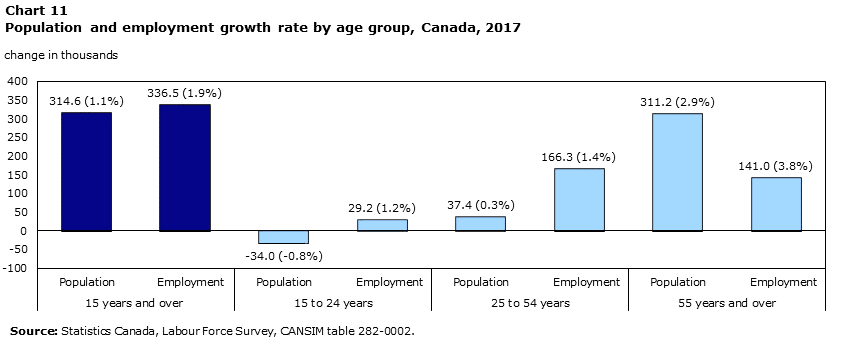
Data table for Chart 11
| Annual change (in thousands) | |
|---|---|
| 15 years and over | |
| Population | 314.6 |
| Employment | 336.5 |
| 15 to 24 years | |
| Population | -34.0 |
| Employment | 29.2 |
| 25 to 54 years | |
| Population | 37.4 |
| Employment | 166.3 |
| 55 years and over | |
| Population | 311.2 |
| Employment | 141.0 |
| Source: Statistics Canada, Labour Force Survey, CANSIM table 282-0002. | |
The unemployment rate for the core age population decreased to 5.4% (-0.6 percentage points), the lowest annual rate since 2008. A larger decline was observed for men (-0.9 percentage points to 5.6%) than for women (-0.2 percentage points to 5.2%).
After two years of increase, the number of core-aged people receiving EI regular benefits declined by 7.8% (-29,000) in 2017.Note The pace of decrease was faster among men in this age group (-10.3%) than among women (-3.5%).
Record high participation rate for core-aged people, driven by women
The participation rate for the core age population reached the highest level since comparable data became available in 1976, up 0.5 percentage points to 87.0% in 2017.Note This was driven by increased labour force participation among women in this age group—their participation rose by 0.7 percentage points to 82.9%, the highest level on record. The participation rate for core-aged men increased slightly to 91.1% (+0.2 percentage points).
The participation rate for core-aged women was highest in Quebec (86.8%) while it was lowest in Ontario (81.2%). Part of this difference may be due to the relatively lower costs of child care in Quebec.Note
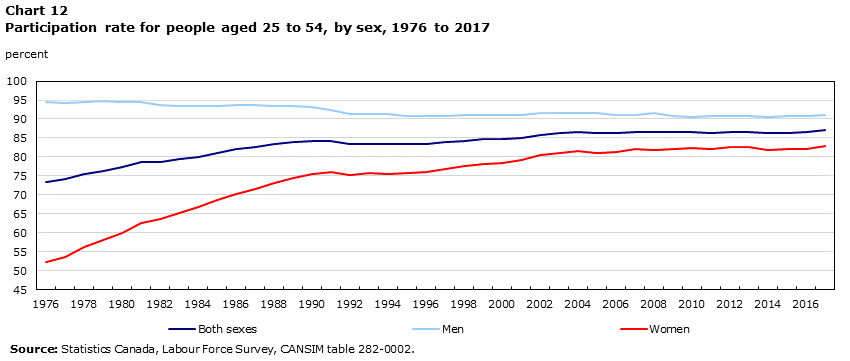
Data table for Chart 12
| Year | Both sexes | Men | Women |
|---|---|---|---|
| percent | |||
| 1976 | 73.5 | 94.5 | 52.3 |
| 1977 | 74.1 | 94.3 | 53.7 |
| 1978 | 75.5 | 94.6 | 56.2 |
| 1979 | 76.4 | 94.7 | 58.0 |
| 1980 | 77.3 | 94.5 | 60.0 |
| 1981 | 78.7 | 94.6 | 62.6 |
| 1982 | 78.6 | 93.6 | 63.5 |
| 1983 | 79.4 | 93.5 | 65.2 |
| 1984 | 80.0 | 93.3 | 66.8 |
| 1985 | 81.1 | 93.5 | 68.7 |
| 1986 | 82.0 | 93.6 | 70.2 |
| 1987 | 82.6 | 93.8 | 71.5 |
| 1988 | 83.3 | 93.5 | 73.1 |
| 1989 | 84.0 | 93.5 | 74.4 |
| 1990 | 84.3 | 93.1 | 75.5 |
| 1991 | 84.1 | 92.4 | 75.9 |
| 1992 | 83.4 | 91.4 | 75.3 |
| 1993 | 83.5 | 91.4 | 75.7 |
| 1994 | 83.3 | 91.2 | 75.4 |
| 1995 | 83.3 | 90.9 | 75.7 |
| 1996 | 83.4 | 90.8 | 76.0 |
| 1997 | 83.9 | 90.9 | 76.9 |
| 1998 | 84.3 | 91.1 | 77.6 |
| 1999 | 84.6 | 91.1 | 78.2 |
| 2000 | 84.8 | 91.0 | 78.5 |
| 2001 | 85.1 | 91.1 | 79.1 |
| 2002 | 85.9 | 91.5 | 80.4 |
| 2003 | 86.4 | 91.6 | 81.1 |
| 2004 | 86.5 | 91.6 | 81.5 |
| 2005 | 86.3 | 91.5 | 81.1 |
| 2006 | 86.2 | 91.1 | 81.2 |
| 2007 | 86.6 | 91.1 | 82.1 |
| 2008 | 86.7 | 91.5 | 81.9 |
| 2009 | 86.5 | 90.8 | 82.1 |
| 2010 | 86.5 | 90.6 | 82.3 |
| 2011 | 86.4 | 90.7 | 82.2 |
| 2012 | 86.6 | 90.8 | 82.5 |
| 2013 | 86.7 | 90.7 | 82.7 |
| 2014 | 86.2 | 90.5 | 81.9 |
| 2015 | 86.4 | 90.9 | 82.0 |
| 2016 | 86.5 | 90.9 | 82.2 |
| 2017 | 87.0 | 91.1 | 82.9 |
| Source: Statistics Canada, Labour Force Survey, CANSIM table 282-0002. | |||
Fastest-growing occupations are management for women, health for men
The number of women working in management occupations increased by 5.7% (+32,000) in 2017, the fastest annual rate since 2004.Note In terms of industry, the growth was driven by female managers in professional, scientific and technical services; finance, insurance, real estate, rental and leasing; educational services; and healthcare and social assistance.Note
Growth in hourly wages and salary for women in this occupational group has outpaced average wage growth for all women for the last three years. In 2017, average hourly wages for women in management occupations grew by 4.1%, four times faster than for their male counterparts (+1.0%).Note
Employment growth in management occupations was also strong among men at 6.7% (+71,000).Note However, the fastest-growing occupational group for men was health occupations, which recorded an increase of 8.9% (+23,000), the fastest annual growth rate since 1993. This was mostly due to gains in the categories of professional occupations in health (except nursing) and technical occupations in health.
Trend of increasing employment continues for older workers
In 2017, employment among people aged 55 and older continued its long-term upward trend, rising by 141,000 (+3.8%).Note The pace of increase was slightly higher for women (+3.9%) than for men (+3.6%). The unemployment rate among older workers declined to 5.6% (-0.4 percentage points), the lowest annual rate since 2008.
The participation rate among women aged 55 and older increased by 0.3 percentage points to 32.7%, bringing the rate for the entire age group (+0.2 percentage points to 37.9%) to the highest level since 1976. Among older men, the participation rate has held steady at 43.5% since 2015.
Increases in the participation rate and employment among older adults are partly due to the transition of the baby-boom generation into this age group. Many factors are associated with higher levels of employment among older Canadians, including higher levels of educational attainment, increased debt levels, increased wages and more favourable employment opportunities, better health, and a labour market increasingly oriented towards the service sector with less manual labour. Also, women turning 55 in more recent years have had higher lifetime labour force participation than earlier cohorts, making it more likely that they will participate as older adults. For more information about the impact of the aging population on the labour force, see the studies: The impact of aging on labour market participation rates and Working seniors in Canada.
Part-time gains and lower unemployment rate for youth
Youth aged 15 to 24 saw an increase in employment of 1.2% (+29,000) in 2017, despite a decline in their population of 0.8%. Gains were driven by a rise in employment among those aged 15 to 19 (+2.3%), while there was little change for those aged 20 to 24 (+0.7%). Unlike core-aged workers, all of the gains for youth were in part-time employment (+30,000 or +2.5%), while full-time employment was virtually unchanged. Employment increased for young men (+1.8% or +22,000) and was little changed for young women (+0.6% or +8,000).
The youth participation rate was 63.9% in 2017, below the recent peak of 67.3% observed in 2008 but little changed from 2016.
Youth had the highest rate of unemployment (11.6%) among the major demographic groups, despite a 1.5 percentage point decline in 2017. For young men, the rate was 13.3%, down 1.5 percentage points to the lowest annual rate since 2008. Among young women, the unemployment rate was 9.9%, a decline of 1.4 percentage points and the lowest annual level since 1989.
Unemployment rate remains higher for Aboriginal people despite strong employment growth
Employment growth was faster among Aboriginal people (+5.2% or +26,900) than it was for non-Aboriginal people (+1.8% or +310,000) in 2017.Note Employment growth for Aboriginal people exceeded their population growth rate in both 2016 and 2017, and was spread across several sectors, with the largest growth observed in educational services as well as wholesale and retail trade.
While the unemployment rate for Aboriginal people declined 1.1 percentage points in 2017 to 11.3%, it remained higher than it was among non-Aboriginal people (6.2%). This discrepancy was also observed for those aged 25 to 54 who had completed postsecondary education. The unemployment rate was 7.8% for Aboriginal people in this group compared with 4.6% for non-Aboriginal people.Note There was variation across the country, with unemployment rates for core-aged Aboriginal people with postsecondary education being higher in the Western provinces (8.8%) than in the Eastern and central provinces (6.7%).
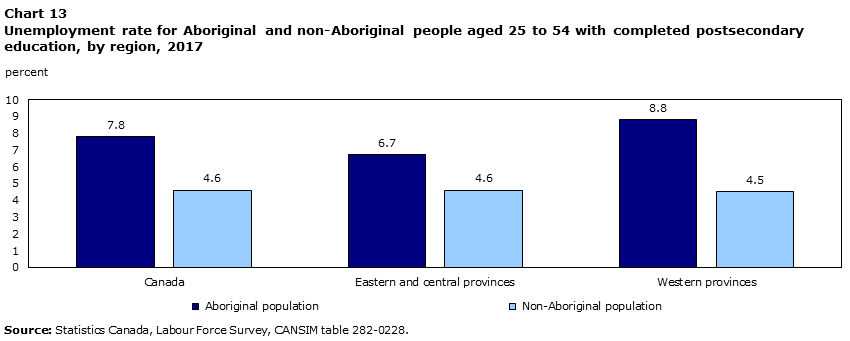
Data table for Chart 13
| Aboriginal population | Non-Aboriginal population | |
|---|---|---|
| percent | ||
| Canada | 7.8 | 4.6 |
| Eastern and central provinces | 6.7 | 4.6 |
| Western provinces | 8.8 | 4.5 |
| Source: Statistics Canada, Labour Force Survey, CANSIM table 282-0228. | ||
Employment growth among immigrants
Employment growth among landed immigrants slowed somewhat to 2.7% (+115,700) in 2017, following two years of growth above 4.0%.Note The unemployment rate for immigrants declined by 0.8 percentage points to 6.7%, the lowest annual rate since comparable data became available in 2006. The unemployment rate among people born in Canada was 6.2%. The gap in the unemployment rate between immigrants and Canadian-born has been less than one percentage point since 2015.
Among the core age population, employment rates were higher for Canadian-born, but improved more among immigrants. The largest increase was among immigrants who landed 5 years or less earlier (+1.6 percentage points). The employment rate for people born in Canada rose by 0.8 percentage points.
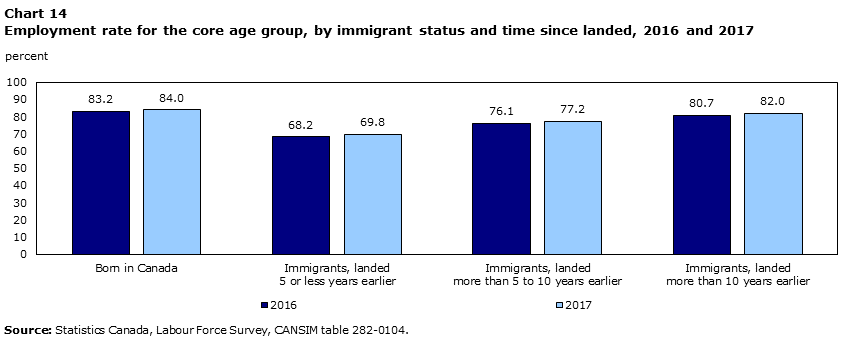
Data table for Chart 14
| 2016 | 2017 | |
|---|---|---|
| percent | ||
| Born in Canada | 83.2 | 84.0 |
| Immigrants, landed 5 or less years earlier |
68.2 | 69.8 |
| Immigrants, landed more than 5 to 10 years earlier |
76.1 | 77.2 |
| Immigrants, landed more than 10 years earlier |
80.7 | 82.0 |
| Source: Statistics Canada, Labour Force Survey, CANSIM table 282-0104. | ||
Other labour market indicators
Involuntary part-time rate continues to decline
Most of the employment increase in 2017 was in full-time work. However, part-time employment also increased (+55,900 or +1.6%).Note The proportion of people who worked part-time (less than 30 hours per week) who report that they would prefer full-time work—known as the “involuntary part-time rate”—continued to decline, down from 25.0% in 2016 to 24.2% in 2017.Note This is the lowest involuntary part-time rate since 2008.
A greater share of those working part-time in 2017 did so by choice; that is, most who worked part-time did so because they were attending school (28.9%) or because of personal preference (27.9%).

Data table for Chart 15
| Proportion of part-time workers, 2017 | |
|---|---|
| percent | |
| Going to school | 28.9 |
| Personal preference | 27.9 |
| Involuntary part-time | 24.2 |
| Caring for children | 9.0 |
| Own illness | 4.1 |
| Other personal or family responsibilities | 4.0 |
| Other voluntary reasons | 1.9 |
| Source: Statistics Canada, Labour Force Survey, CANSIM table 282-0014. | |
Provincially, the number of people reporting that they were working part-time involuntarily declined in most provinces. British Columbia had the lowest rate, at 20.7% and Quebec the second lowest, at 20.9%. The proportion of involuntary part-timers was highest in Newfoundland and Labrador and grew notably to a rate of 37.3% in 2017 (up 3.8 percentage points). It also increased in Saskatchewan (up 2.8 percentage points to 23.6%). In Alberta, the rate of involuntary part-time employment declined in 2017 (down 0.6 percentage points to 26.2%), and remained above the national average for a second year in a row.
Long-term unemployment little changed and labour under-utilization down
In Canada, the proportion of long-term unemployed people—that is, jobseekers for 53 weeks or more—was little changed in 2017, at 6.9%.Note The proportion of long-term unemployed has been generally around 7.0% since 2010.
Supplementary measures of unemployment shed further light on the under-utilization of labour. The most comprehensive supplementary rate (R8) includes not only those searching for work, but also discouraged searchers, the under-utilized portion of involuntary part-timers, as well as those waiting for recall, and with long-term future starts. In 2017, that supplementary rate (R8) was at 9.1%, down from 9.8% in 2016.Note The R8 has been decreasing since it last peaked in 2009.
Following a record high in 2016, the R8 in Alberta declined by 0.4 percentage points to 10.7%, the result of a decline in the number of involuntary part-timers as well as a decline in the number of discouraged searchers in the province.
Growth in temporary positions outpaces permanent ones
The number of employees rose by 299,000 (+2.0%) in 2017, and most of the increase was among employees with permanent positions (+192,000). The number of temporary employees was up 107,000, boosted by an increase in employees with term or contract jobs.Note
There were more permanent employees than temporary employees (13.5 million vs. 2.1 million) in 2017. However, the number of employees with a temporary job grew at a much faster pace than those with a permanent job (5.3% compared with 1.4%). On average, the number of employees with temporary jobs has been growing at a faster pace than those with a permanent job since 1997.
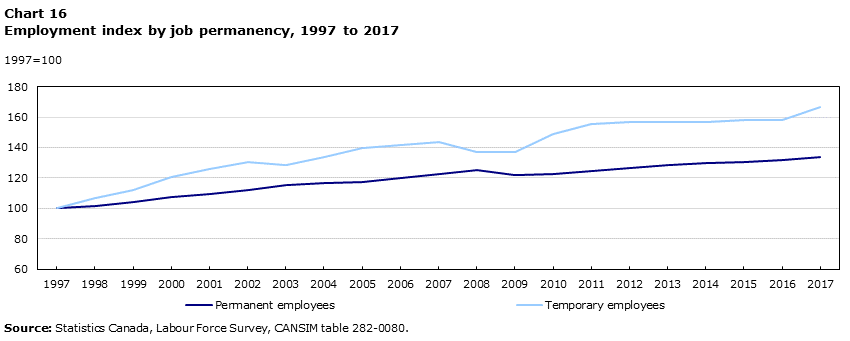
Data table for Chart 16
| Year | Permanent employees | Temporary employees |
|---|---|---|
| 1997=100 | ||
| 1997 | 100.0 | 100.0 |
| 1998 | 101.8 | 106.9 |
| 1999 | 104.4 | 112.0 |
| 2000 | 107.5 | 120.4 |
| 2001 | 109.5 | 126.0 |
| 2002 | 112.0 | 130.6 |
| 2003 | 115.1 | 128.3 |
| 2004 | 116.5 | 133.7 |
| 2005 | 117.2 | 139.7 |
| 2006 | 119.8 | 141.6 |
| 2007 | 122.3 | 143.4 |
| 2008 | 125.0 | 137.3 |
| 2009 | 121.8 | 137.1 |
| 2010 | 122.8 | 148.6 |
| 2011 | 124.6 | 155.3 |
| 2012 | 126.4 | 156.9 |
| 2013 | 128.5 | 156.6 |
| 2014 | 129.6 | 156.9 |
| 2015 | 130.5 | 158.2 |
| 2016 | 131.7 | 158.2 |
| 2017 | 133.6 | 166.6 |
| Source: Statistics Canada, Labour Force Survey, CANSIM table 282-0080. | ||
In 2017, the sectors with the largest gains in permanent employees were wholesale and retail trade; finance, insurance, real estate, rental and leasing; transportation and warehousing; and construction. Among temporary employees, the largest increases were observed in health care and social assistance; public administration; and wholesale and retail trade.
Multiple job holders
In 2017, 5.6% of employed people had more than one job, little changed compared with 5.5% in 2016.Note Of all workers with multiple jobs, 19.2% had their main job in health care and social assistance, 13.4% in wholesale and retail trade and 10.3% in educational services.
Youth aged 15 to 24 were most likely to work multiple jobs, at a rate of 6.9%, down slightly from 2016 (-0.3 percentage points). Among core-aged people, 5.8% worked multiple jobs, while people aged 55 and older were least likely to work multiple jobs, at a rate of 4.5%.
Conclusion
This article highlights several key developments in the labour market observed in 2017. Overall, there were strong signs of growth, including the fastest total employment growth in a decade, which was mostly in full-time work. There was also a downward trend in the national unemployment rate, and a decline in Employment Insurance beneficiaries. At the same time, average weekly earnings increased in almost all provinces.
Employment growth was spread across several sectors, led by health care and social assistance. At the same time, there was some resurgence from goods-producing sectors such as manufacturing, construction, and mining, quarrying and oil and gas extraction.
Ontario, Quebec, British Columbia and Prince Edward Island showed the strongest rate of employment growth in 2017. On the other hand, the labour market in Newfoundland and Labrador showed notable declines, although earnings remained strong. Alberta also lacked the typical strength in employment and earnings growth which had been observed prior to the oil price shock in 2014, and the unemployment rate in the province remained relatively high, despite trending down throughout 2017.
Employment growth outpaced population growth among all major demographic groups, with record-high participation rates among core-aged and older people. There was also strong employment growth among Aboriginal people and immigrants. Employment increased faster among public sector employees compared with private sector employees and the self-employed.
Several longer-term labour market trends continued in 2017, including increasing employment among people aged 55 and older, a decline in involuntary part-time work, and an increase in temporary employment.
- Date modified: